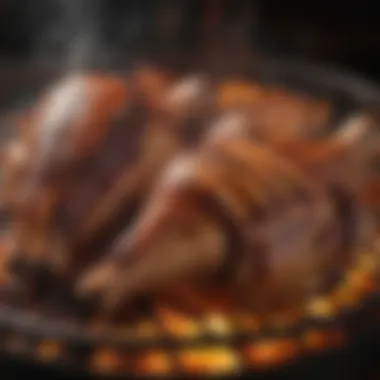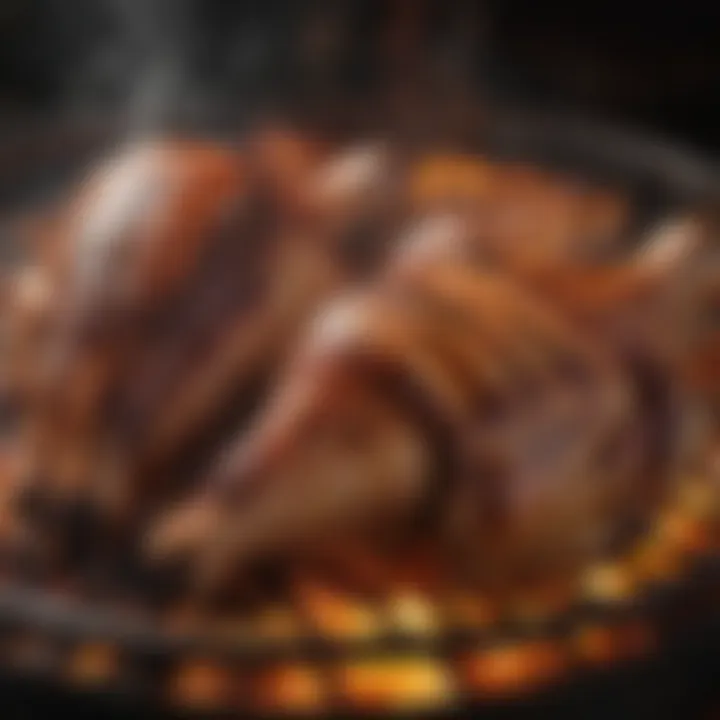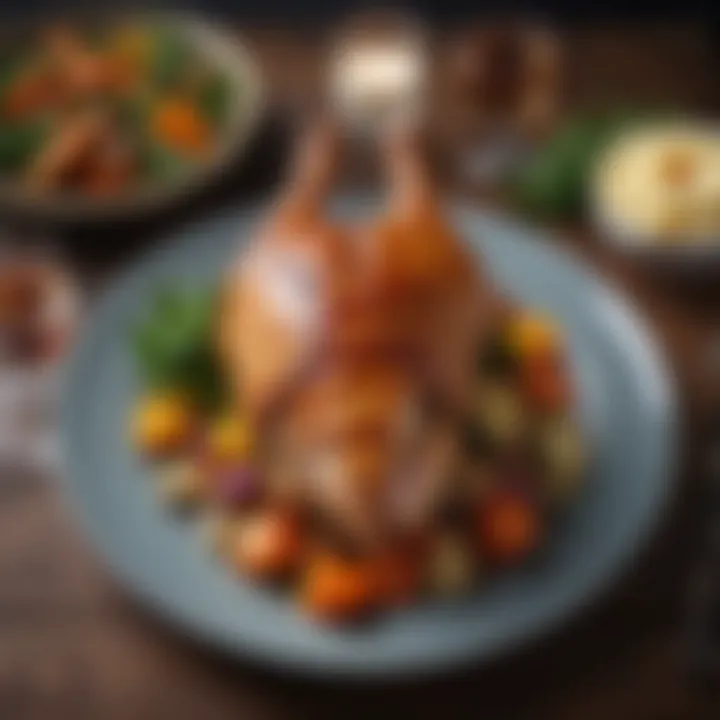The Ultimate Guide to Cooking Turkey Legs


Intro
Cooking turkey legs can be a rewarding culinary experience. They are flavorful, versatile, and can serve as the centerpiece of many meals. However, achieving the right balance of tenderness and flavor requires a thoughtful approach. This guide provides a comprehensive look at the selection, preparation, cooking techniques, and serving suggestions for turkey legs. Whether you are a novice cook or more experienced in the kitchen, understanding the intricacies of cooking turkey legs will elevate your culinary skills.
Recipe Overview
- Recipe name: Herb-Roasted Turkey Legs
- Brief description of the dish:
Herb-roasted turkey legs, seasoned with a blend of fresh herbs and spices, offer a savory taste that captivates the palate. The cooking method enhances the natural flavors while delivering a crispy exterior and moist meat on the inside. This dish can be served during any festive occasion or as a hearty family dinner.
Ingredients List
- Main ingredients:
- Optional ingredients:
- Turkey legs
- Olive oil
- Fresh rosemary
- Fresh thyme
- Garlic
- Salt and pepper
- Lemon juice
- Paprika
- Onion powder
- Dried cranberries for garnish
Understanding the right ingredients is vital for achieving the desired flavors in your turkey legs. The main ingredients serve as the foundation, while optional ingredients can enhance the overall dish. When it comes to cooking turkey legs, freshness matters greatly.
Prelims to Turkey Legs
Cooking turkey legs requires thoughtful consideration and awareness of different aspects involved. This section serves to orient the reader by outlining the significance of turkey legs in culinary practices. Turkey legs are often seen as underappreciated cuts that deserve recognition, especially due to their taste and texture. They can provide a satisfying meal when prepared correctly, and they allow for a variety of cooking techniques that can adapt to diverse palates.
Understanding Turkey Legs Variations
Turkey legs are not a one-size-fits-all product. There are several variations, each offering unique flavor profiles and texture qualities. The most common are fresh and frozen legs. Fresh turkey legs tend to have a richer taste and better texture, while frozen legs can be more convenient and often are more readily available in grocery stores. Understanding these varieties helps in selecting the right turkey leg for a specific recipe or cooking style.
Additionally, some regions or markets may offer specialized breeds, such as heritage turkeys, which can alter the taste significantly.
Culinary Appeal of Turkey Legs
Turkey legs hold substantial culinary appeal for multiple reasons. First, they are generally more flavorful compared to other cuts, such as turkey breasts. This is largely due to the higher fat content in legs, providing moisture and richness. This makes them suitable for various cooking methods that enhance their intrinsic qualities. The deep, savory flavor pair well with numerous spices and marinades, allowing for creative expression in the kitchen.
Moreover, turkey legs are versatile in their presentation, whether served as main dishes or as part of festive meals. They fit comfortably within numerous cuisines and can be found in barbecue pits, holiday gatherings, and family dinners. The ability to infuse various flavors through seasoning opens the door for culinary exploration and enjoyment.
By understanding their unique characteristics, home cooks can guarantee that they serve not just a meal but an experience that delights the taste buds.
"Cooking turkey legs properly can unlock a rich and robust flavor that turns a simple dish into a culinary delight."
Epilogue
Selecting Turkey Legs
Selecting turkey legs is a critical step that influences the overall outcome of your culinary experience. The process begins before you even set foot in the kitchen. An informed choice ensures that you receive the best quality meat that will remain tender and flavorful throughout your cooking journey. The right selection will not only make your cooking efforts easier but also lead to better flavor and texture in the final dish. This section will explore the comparison of fresh and frozen turkey legs and how to identify quality turkey legs.
Fresh vs. Frozen Turkey Legs
When considering turkey legs, you will often face the choice between fresh and frozen options. Both have their merits and drawbacks, depending on your availability and preferences.
Fresh turkey legs are usually available during peak seasons. They have a shorter shelf life but tend to offer a fresher, more robust flavor compared to their frozen counterparts. Additionally, fresh turkey legs involve less preparation work as they do not require thawing, making them great for last-minute meals. However, the freshness may cost more and can sometimes be difficult to locate in stores.
On the other hand, frozen turkey legs provide a practical advantage. They offer long-term storage, allowing you to buy in bulk and cook at your convenience. This can be particularly useful if you anticipate the need for turkey legs in future meals. However, frozen turkey legs require proper thawing to ensure even cooking, which may take a few hours or overnight in the refrigerator. It's important to note that the flavor may slightly diminish, although cooking methods, such as marinating, can help mitigate that.
In summary, your choice between fresh and frozen turkey legs should consider factors such as timing, availability, and budget. Knowing when to choose each option can help ensure a successful culinary endeavor.
Identifying Quality Turkey Legs
Identifying quality turkey legs is vital to achieving excellent results. When inspecting turkey legs, several elements indicate freshness and quality:


- Skin Appearance: Look for skin that is intact, with a natural color and no signs of discoloration or excessive drying. Skin should be moist but not slimy.
- Color: The meat should be a pale pink to light tan. Dark spots or a greyish color may suggest deterioration.
- Texture: Press the meat gently; it should be firm but not hard. A good quality turkey leg will bounce back slightly when pressed.
- Aroma: Fresh turkey should have a light, clean scent. A sour or off-putting odor is a clear sign of spoilage.
- Source: Whenever possible, buy from reputable butchers or farms where you can ask about the turkey's origins and handling practices.
In essence, always trust your senses when selecting turkey legs. The look, feel, and smell can guide you to the right choice.
By focusing on these qualities, you can ensure that the turkey legs you select will contribute positively to your cooking experience, ultimately leading to a delectably satisfying meal.
Preparing Turkey Legs
Preparing turkey legs is crucial to achieving a flavorful and tender result. This phase is often overlooked, but it lays the foundation for the entire cooking process. Proper preparation can enhance taste, improve texture, and ensure safety. Furthermore, it allows the cook to customize flavors through marination and seasoning, making the dish more appealing.
Thawing Frozen Turkey Legs Safely
Thawing frozen turkey legs must be conducted with care to prevent bacterial growth. The best methods are:
- Refrigerator Thawing: Placing turkey legs in the refrigerator is the safest method. It requires time, approximately one day for every four to five pounds. This method keeps the meat at a safe temperature.
- Cold Water Thawing: If you need a faster option, submerge the turkey legs in cold water. Change the water every 30 minutes. This method takes about 30 minutes per pound.
Avoid thawing turkey legs at room temperature. This can lead to uneven heating and risky bacteria developments.
Marinating and Seasoning Techniques
Marinating turkey legs can add layers of flavor while also helping to tenderize the meat. The best marinades contain acid, such as lemon juice or vinegar, combined with oil, and various seasonings. Here are some successful techniques:
- Dry Rubs: Mixing spices like paprika, garlic powder, and black pepper creates a flavorful crust. Apply the rub generously and let marinate for at least one hour, or overnight for fuller flavor.
- Wet Marinades: Combine soy sauce, honey, garlic, and herbs for a savory-sweet flavor. Soak turkey legs in the marinade for an extended period, ideally 12 hours.
Marinating improves not just flavor but also moisture in the cooking process. Well-seasoned turkey legs will stand out on the dinner plate.
Trimming and Cleaning Turkey Legs
Before cooking, it is important to trim off excess skin and fat. This ensures that the turkey legs cook evenly and prevents greasiness. Clean the legs thoroughly under cold water.
Key considerations include:
- Identify and Remove: Look for any fatty pockets or blemishes and carefully cut these away with a sharp knife.
- Rinse and Pat Dry: After trimming, rinse the legs to remove blood and other impurities. Gently pat dry with paper towels to prepare them for marination or cooking.
Taking these steps ensures that the meat is clean and ready for the final cooking process, which is imperative for a successful dish.
Proper preparation of turkey legs is essential for maximizing flavor and ensuring safety.
Cooking Turkey Legs
Cooking turkey legs is a fundamental aspect of preparing this delicious and substantial protein. Understanding different methods and techniques is essential to achieve flavor, tenderness, and overall satisfaction when serving turkey legs. This section delves into various ways to cook turkey legs, highlighting roasting, grilling, smoking, and braising. Each method brings not only unique tastes but also requires different levels of skill and equipment. Therefore, it is beneficial for any home cook to master these techniques.
Roasting Techniques
Roasting turkey legs is perhaps one of the most popular methods. This technique involves cooking the legs in an oven, allowing for even heating and a delightful crisp exterior. The key elements include choosing the right temperature; most recipes recommend between 325°F to 375°F. Seasoning before roasting is critical. A good marinade can enhance the natural flavors of turkey legs. It's crucial to baste the legs occasionally; this keeps them moist and adds flavor. A roasting pan is ideal, as it collects the drippings for making gravies or sauces.
Grilling Methods
Grilling turkey legs introduces a distinct flavor profile, marked by those quintessential char marks that signify excellent grilling. First, preparing the grill is essential. This can be done by preheating to a medium heat. Applying a dry rub or marinade a few hours earlier increases flavor absorption. Once on the grill, monitor the legs closely to avoid overcooking. Flip them regularly to ensure even cooking while also keeping them juicy. Using a meat thermometer can help confirm doneness without cutting into the meat.
Smoked Turkey Legs Preparation
Smoking turkey legs is a method that maximizes flavor through a low and slow cooking process. This technique infuses the meat with a rich, smoky taste that many enjoy. A smoker or a charcoal grill can be used effectively for this purpose. Selecting the right wood is a vital step; applewood or hickory are popular choices. First, brining the legs helps retain moisture during the long cooking process. Smoking typically takes around 3 to 4 hours at a consistent low temperature, ideally around 225°F. Periodically checking the internal temperature ensures the meat reaches the desired doneness.
Braised Turkey Legs Approaches


Braising turkey legs is an excellent choice for achieving tender meat that falls off the bone. This technique involves cooking the legs slowly in a covered pot with a small amount of liquid, which helps to evaporate the tough fibers in the meat. The process starts with browning the turkey legs in a pan to develop depth of flavor. After browning, add aromatics like garlic, onions, and herbs, along with broth or wine. Cover the pot and let it simmer on low heat, either on the stove or in the oven. This indirect heat allows the meat to cook evenly while absorbing all the flavors from the braising liquid.
"The secret to tender turkey legs lies in patience and the right cooking technique."
In summary, knowing how to cook turkey legs through various methods ensures that you can provide a satisfying meal for anyone you serve. Each technique has its benefits and flavors, allowing for versatility in your culinary repertoire.
Monitoring Cooking Progress
Monitoring cooking progress is a fundamental aspect when preparing turkey legs. This ensures that the meat cooks evenly and achieves the desired tenderness and flavor. Understanding the different ways to monitor cooking, such as checking internal temperatures and recognizing visual cues for doneness, can greatly enhance your culinary experience. Effective monitoring helps prevent undercooking, which can pose health risks, and overcooking, which can lead to dry, unappetizing meat.
Understanding Internal Temperatures
Cooking turkey legs to the appropriate internal temperature is vital for both safety and taste. The United States Department of Agriculture (USDA) advises that poultry, including turkey legs, should reach an internal temperature of at least 165°F (73.9°C). However, for optimal juiciness and tenderness, cooking to a slightly higher internal temperature, specifically around 180°F (82.2°C), is often recommended. At this temperature, the connective tissues break down effectively, resulting in meat that is easier to shred and richer in flavor.
Using an instant-read thermometer is an effective and simple way to check the internal temperature. Insert the thermometer into the thickest part of the meat, avoiding the bone, since the bone can conduct heat and give a false reading. This method not only ensures food safety but also helps in achieving the perfect texture that many cooks desire.
Visual Cues for Doneness
In addition to temperature, visual cues can be utilized to assess whether turkey legs have reached doneness. Here are some key indicators:
- Color: When cooked properly, the meat should appear opaque, and the juices should run clear rather than pink. The skin can turn a golden brown, indicating that it has cooked through.
- Texture: Press the meat gently with a fork or tongs. If it feels firm and the juices run clear, it is likely done. If it feels soft and squishy, it may need additional cooking time.
- Separation from the Bone: As turkey legs cook, the meat begins to pull away from the bone. If this separation is noticeable, it is a good sign that the legs are nearly ready.
Always approach monitoring with patience. Each turkey leg may vary in size and shape, leading to slight variations in cooking times.
Combining these methods provides a comprehensive understanding of when your turkey legs are finished cooking. By focusing on both internal temperatures and visual cues, you will enhance your cooking results and ensure a satisfying meal.
Serving Suggestions
Serving suggestions play a significant role in the overall dining experience with turkey legs. They elevate the dish from a simple meal to a memorable feast. The combination of flavors, textures, and presentation contributes to how the dish is perceived and enjoyed. It is essential to consider not only what accompanies the turkey legs but also how those elements complement the main dish.
Incorporating well-chosen side dishes alongside turkey legs can enhance the meal's nutritional profile. These pairings can also create a harmonious balance. Considerations include seasonal availability, dietary restrictions, and personal preferences. This section will explore possible side dishes and sauce options that can create a delightful culinary experience when serving turkey legs.
Pairing Side Dishes
Choosing side dishes that align with the flavors of turkey legs is crucial. Common side dishes include:
- Mashed Potatoes: Their creamy texture contrasts nicely with the meat.
- Roasted Vegetables: Seasonal vegetables add color and nutrition to the plate.
- Stuffing or Dressing: Classic flavors can enhance the turkey's savory aspect.
- Green Beans or Asparagus: These provide freshness and a crisp texture.
- Coleslaw: This adds a crunchy element and a bit of acidity.
When selecting sides, think about the flavor profile and spices used in the turkey preparation. A spice-heavy turkey may pair well with simple, mild sides to avoid overwhelming the palate. Balancing hearty foods with lighter options also creates a satisfying meal. For example, if the turkey is heavily seasoned, a simple salad might bring relief to the richness of the dish.
Paying attention to presentation is also important. Arrange the side dishes in a way that is visually appealing. A well-plated meal can enhance the dining experience.
Sauces and Gravies for Turkey Legs
The right sauce or gravy can elevate turkey legs significantly. These condiments can deepen flavors and add moisture to the dish. Here are some popular choices:
- Traditional Gravy: Made from turkey drippings, it's a classic and satisfying addition.
- Cranberry Sauce: Its tartness contrasts beautifully with the savory flavors.
- BBQ Sauce: A sweet and tangy option that complements grilled turkey legs well.
- Mushroom Sauce: Provides a rich, earthy flavor that pairs effectively with roasted legs.
When preparing sauces, consider the cooking method of the turkey legs. For example, a smoked leg might benefit from a fruity sauce that balances the smoky taste. On the other hand, roasted legs could be enhanced with a creamy gravy.
In concluding this section, keep in mind that serving suggestions should enhance the primary focus—the turkey legs. Balance flavors, textures, and appearances to provide an enjoyable dining experience.
Storage and Reheating


Proper storage and reheating are essential components in ensuring the quality and safety of cooked turkey legs. Once the cooking is complete, how you handle the leftovers can significantly impact their taste, texture, and safety for future meals. Knowing how to store turkey legs correctly not only preserves their flavor but also extends their shelf life. Reheating them properly ensures that you enjoy a meal that is as satisfying as it was when first prepared. By understanding these methods, cooks can avoid waste and make the most of their culinary efforts.
Proper Storage Techniques
Once the turkey legs have cooled, they should be stored promptly to maintain their freshness. Here are some best practices for storing cooked turkey legs:
- Cool Down Quickly: Allow the turkey legs to come to room temperature, but do not leave them out for more than two hours to prevent bacterial growth.
- Use Airtight Containers: Store turkey legs in airtight containers or tightly wrap them in aluminum foil or plastic wrap. This prevents moisture loss and protects against exposure to air, which can lead to freezer burn if stored incorrectly.
- Label and Date: If you are freezing turkey legs, it is wise to label the containers with the date. This helps you keep track of how long the legs have been stored and ensures you use them within a safe timeframe.
- Refrigeration: Cooked turkey legs can last for up to four days in the refrigerator. If you do not plan to consume them within this period, freezing is the recommended option.
Proper storage practices are vital to prolonging the life of your turkey legs while retaining optimal taste and safety.
Safe Reheating Methods
When it's time to enjoy the leftover turkey legs, reheating them correctly is crucial for both safety and flavor. Here are effective methods for reheating:
- Oven Reheating: Preheat the oven to 325°F (163°C). Place the turkey legs in a baking dish and cover with foil to prevent them from drying out. Heat for about 20 to 30 minutes or until they reach an internal temperature of 165°F (74°C).
- Microwave Reheating: Place the turkey legs on a microwave-safe plate. Cover the plate with a damp paper towel to keep moisture in. Heat on medium power in 1-minute increments until heated through, checking frequently.
- Stovetop Reheating: Heat a skillet over medium heat. Add a splash of broth or water, then place the turkey legs in the skillet. Cover and heat gently for about 10 to 15 minutes, turning occasionally.
By adhering to these storage and reheating guidelines, you can ensure that the turkey legs maintain their flavor and texture, providing an enjoyable dining experience anytime.
Health Considerations
When it comes to cooking turkey legs, understanding the health considerations is crucial for both enthusiasts and home cooks. Turkey legs, while delicious, can also be part of a balanced diet if prepared mindfully. This section focuses on the nutritional facts and the impact of dietary restrictions, allowing readers to make informed choices about their consumption.
Nutritional Profile of Turkey Legs
Turkey legs are an excellent source of protein, essential for muscle development and repair. Just one serving can provide a significant portion of your daily protein needs. In addition to protein, turkey legs furnish several vitamins and minerals. Notably, they are rich in B vitamins, including niacin and B6, which play crucial roles in energy metabolism and cognitive health.
Key Nutritional Aspects:
- Protein: Helps in muscle repair and growth.
- Fat: Contains healthy fats but consider skin removal to reduce saturated fat intake.
- Minerals: Provides zinc, phosphorus, and potassium, supporting numerous bodily functions.
- Vitamins: Rich in B vitamins promoting energy metabolism.
It’s important to note that the nutritional content can vary based on how the turkey legs are prepared. Frying can increase the calorie count and fat content, while roasting or grilling may retain more nutrients.
Dietary Restrictions and Options
Understanding dietary restrictions is essential when serving turkey legs, especially in diverse gatherings. Common dietary considerations include:
- Gluten-Free: Turkey legs are naturally gluten-free, making them a safe choice for those with gluten sensitivities or celiac disease.
- Low-Fat Options: For those monitoring fat intake, it's advisable to remove the skin and opt for healthier cooking methods such as baking or steaming.
- Low-Sodium Diets: Be cautious with seasoning. Use salt substitutes or low-sodium solutions to make the dish healthier.
- Keto and Paleo-Friendly: Turkey legs fit well into high-protein and low-carbohydrate diets, providing necessary nutrients without excessive carbs.
In summary, turkey legs offer a versatile and nutritious option for many dietary needs. By being aware of cooking methods and ingredient choices, one can enjoy turkey legs while adhering to health goals.
Closure
The conclusion of this article holds a significant role in synthesizing the complex and detailed discourse on cooking turkey legs. By recapping the essential aspects, it emphasizes the importance of understanding the entire process. Turkey legs, with their robust flavor, can be an excellent choice for a hearty meal when prepared correctly. A well-prepared turkey leg should be tender, juicy, and full of flavor, attributes achievable through the right methods of selection, seasoning, and cooking.
In this guide, several cooking techniques were outlined, from roasting to braising, each offering unique flavors and textures. The recap reinforces the idea that each step in cooking turkey legs contributes to the overall success of the dish. Understanding internal temperatures and visual cues assures that the turkey legs are cooked safely and deliciously. By considering various health aspects and dietary preferences, the article not only aims to broaden the culinary experience but also makes it accessible to everyone.
Recap of Cooking Turkey Legs
In the journey of cooking turkey legs, we learned about the essential steps, starting from the selection of high-quality legs to preparing them through effective thawing and marinating techniques. Cooking methods discussed included:
- Roasting: This traditional method enhances the natural flavors and produces a wonderfully crispy skin.
- Grilling: Ideal for outdoor cooking, giving a nice char and smoky taste.
- Smoking: Offers a deep infusion of flavor that complements the leg's richness.
- Braising: This technique results in tender meat that falls off the bone, merging flavors beautifully.
Monitoring the cooking process ensures successful outcomes, with attention given to internal temperatures and visual cues. Serving suggestions paired with appropriate side dishes and sauces elevate the dining experience.
Encouragement for Culinary Exploration
Encouraging exploration in the kitchen is vital. Each cook has a unique style and approach that can improve with practice. While this guide serves as a foundational resource, it encourages individual creativity. Experimentation can open the door to unexpected flavors and techniques. Consider:
- Trying different spices and herbs in marinades.
- Exploring various cooking methods based on personal preference.
- Adapting traditional recipes to suit modern tastes and dietary needs.
As you engage with the procedures discussed, remember that cooking is as much about process as it is about the end result. Dive into the world of flavors and textures that turkey legs can bring, and allow your culinary skills to evolve.







